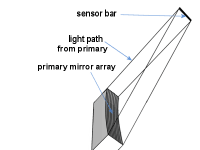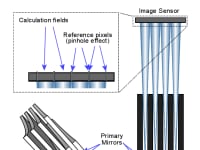This design provides a large amount of aperture in a package that is well suited for transport into space. Instead of the large disc of a conventional telescope, the Compact Space Telescope's primary mirror assembly is an array of thin mirrors and baffles forming a long parabolic trough making it a great match for a cargo hold. Also, much of the telescope's work has been offloaded to the electronics and software increasing the efficiency of captured light.
The telescope is made to be in motion with the field of study moving somewhat perpendicular to the length of the array. In a terrestrial application, the array would be mounted in a North-South orientation using the Earth’s rotation to move the field of study.
An image is formed by the primary mirrors only along the horizontal axis of the sensor. Before post-processing, raw images appear to be smeared across most of the vertical axis. Data must be extracted from the “smeared” images formed by the flat axis of the parabolic troughs.
Baffles on the sides of each mirror segment create a thin line of focused light at the start and end of each segment’s reach. A clear image is formed at these points because of the pinhole camera effect created by the baffles. I call these strips of accurate vertical image “reference pixels”. These image sections will form the first image scan and then later be used to algebraically extract data from the rest of the segment’s “smear” which I call the “calculation field” and use it to amplify results from the reference pixel scans.
Each segment’s results can then be combined to form a more accurate final image.
For best results, the sensor should be able to capture at least one image per each relative pixel movement in the field of view. This design allows for a very long single sensor or sensor array with much more surface area for heat dissipation than would be possible on a conventional telescope allowing faster frame capture rates.
Used in space, the raw video frames would need to be transmitted to Earth to be interpreted by software. The software would first run through a series of frames to identify the reference pixels (sharpest image points separated by dark pixels), then analyse reference pixel data to determine rotation speed and skew. The program would then have enough information to calculate the remainder of the video data and complete the software component of the image scanning process.
Hardware improvements are mainly limited by the ability of the software to extract data. For instance, much thinner baffles could be used if the software could handle overlapping segment fields on the sensor creating more aperture within the same mirror array dimensions.
Manufacturing the mirror array will require a grinder and polisher set up to form linear parabolas along the edge of both the mirror substrate and baffles. As with any telescope mirror, they must be polished and coated to a very exacting tolerance.
Voting
-
ABOUT THE ENTRANT
- Name:Scott Jordan
- Type of entry:individual
- Number of times previously entering contest:1
- Scott's hobbies and activities:Astronomy
- Scott belongs to these online communities:Google+
- Patent status:none





